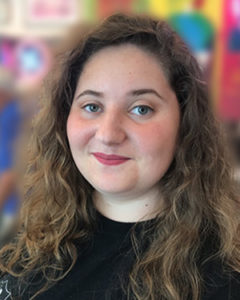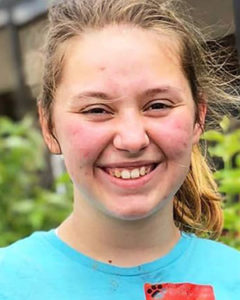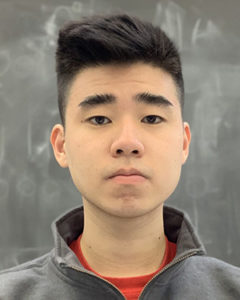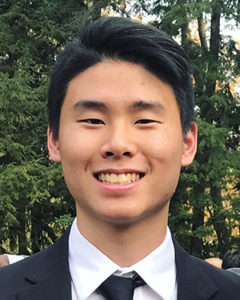13 undergraduates have been awarded funds for summer internships through the Peter B. Lewis Fund for Student Innovation in Energy and the Environment and the Dede T. Bartlett P03 Fund for Student Research in Energy and the Environment. The recipients will spend the summer working at environmental organizations across the country or conducting research under the guidance of a faculty advisor. The students’ projects, described below, are aimed at providing solutions to energy and environment-related challenges.
Off-Campus Internships:
 Celine Park (MAE ’21) working at American Council for an Energy Efficient Economy (ACEEE), Washington, DC
Celine Park (MAE ’21) working at American Council for an Energy Efficient Economy (ACEEE), Washington, DC
Valuing Energy Use in Real Estate Listings
The ACEEE Behavior and Human Dimensions Program conducts research on energy efficiency from a behavioral perspective and will be examining these questions through a combination of research and experimentation. Background literature reviews, as well as interviews with real estate experts, realtors, and homebuyers will be conducted in order to inform the design and implementation of a discrete choice experiment. The student will assist with this project and others conducted by the Behavior and Human Dimensions program. The study will be published by ACEEE in 2020 with the goal of informing real estate professionals and policy makers of the value of home energy efficiency metrics.
 Jessica Fielding (COS ’21) working at Climate Central, Princeton, NJ
Jessica Fielding (COS ’21) working at Climate Central, Princeton, NJ
Datasets and Tools to Inform Meteorologists
The “Climate Matters” program at Climate Central provides localized information to TV meteorologists across the U.S. for on-air use to inform their viewers about topics related to climate change. During 2018, the Climate Matters team developed an online tool that provides daily forecasts of wind and solar electricity generation for individual media markets, using data on actual installed capacity and weather forecasts. The student will extend the tool’s capabilities and enhance the tool’s user experience by updating underlying databases, designing and writing code to extend functionalities for the tool, conducting analysis to assess accuracy of forecasts, and synthesizing archived historical forecasts.
On-Campus Internships:
 Cosmin Andrei (ELE ’22) working with Howard Stone (MAE) and Ankur Gupta (MAE)
Cosmin Andrei (ELE ’22) working with Howard Stone (MAE) and Ankur Gupta (MAE)
Fast Charging Energy Storage Devices
Electrochemical capacitors are energy storage devices that have ideal characteristics for rapid charging and discharging applications. Recently, a special class of electrochemical capacitors based on flowable electrodes has gained interest. The student will perform experiments and modeling of these electrochemical flow capacitors, including measurements of the electrical properties and rheology of typical multiphase materials proposed for these applications.
 Bryce Bickel (CBE ’21) working with José Avalos (CBE/ACEE)
Bryce Bickel (CBE ’21) working with José Avalos (CBE/ACEE)
Biotechnology for Renewable Energy and Sustainable Manufacturing
This project will focus on developing microbial strains (yeast or bacteria) to genetically engineer their metabolisms for the production of biofuels or chemicals. This will involve assembling metabolic pathways for the biosynthesis of products of interest and deleting genes for enzymes that compete with the pathway of interest. The student will develop genetically encoded biosensors and apply them to monitor the metabolic activity of cells and facilitate high-throughput strain screening. Optogenetic circuits will be constructed to dynamically control fermentations with light. Microbial fermentations will be carried out and products will be analyzed with chromatography.
 Krystal Delnoce (CEE ’21) working with Claire White (CEE/ACEE)
Krystal Delnoce (CEE ’21) working with Claire White (CEE/ACEE)
The Materials Science of Sustainable Cements and Materials for CO2 Capture
Concrete, the second most used substance on earth after water, is responsible for 5-8% of all human-made CO2 emissions. The research group is focused on developing new sustainable concrete by understanding and optimizing the sub-micron processes (i.e., reactions) occurring in conventional and alternative cements. Moreover, the ability to capture CO2 using novel materials is a key research area being explored by the group. The summer undergraduate project will complement one of the ongoing projects being undertaken in the group, and will include synthesizing materials and using various experimental characterization equipment, such as X-ray diffraction and Fourier-Transform infrared spectroscopy.
 Andres Irribarra Ramirez (CHM ’20) working with Greg Scholes (CHM)
Andres Irribarra Ramirez (CHM ’20) working with Greg Scholes (CHM)
Photocatalyst Development
Photocatalysts absorb light and apply the energy from light to a chemical reaction. The student will synthesize and characterize a new photocatalyst. The photocatalyst’s electronic structure will be characterized by electronic absorption (UV-vis) spectroscopy, 1H NMR, cyclic voltammetry, spectroelectrochemistry, steady-state emission spectroscopy and transient absorption spectroscopy. Excited-state electron transfer and energy transfer of the photocatalyst will be evaluated. The energy level of an excited state of a photocatalyst will be determined using organic dyes and transient absorption spectroscopy. The student will also investigate light-activated electron transfer with the photocatalyst and a series of electron acceptor molecules.
 Deniz Keles (Visiting student-ORFE ’20) working with Elke Weber (PSY/ACEE/WWS)
Deniz Keles (Visiting student-ORFE ’20) working with Elke Weber (PSY/ACEE/WWS)
Behavioral Components of Decarbonization
This project focuses on the deep and rapid decarbonization of India and the United States as part of an international research collaboration called Rapid Switch. The research aims to model perceptions of and responses to energy policy and system change. Over the summer, the student will join the Behavior Science for Policy Lab in investigating norms and attitudes relating to energy technology adoption in the Northeast United States. The student will help identify behavioral barriers to decarbonization through a combination of fieldwork, survey tools, text analysis, and collaboration with energy stakeholders.
 Jarrad Li (CBE ’22) working with Sankaran Sundaresan (CBE)
Jarrad Li (CBE ’22) working with Sankaran Sundaresan (CBE)
Plasma-Assisted Catalytic Synthesis of Ammonia
The research group studies plasma-assisted heterogeneous catalytic reactions in dielectric barrier discharge (DBD) reactors to create ammonia. Using a new type of DBD reactor with porous flow-through electrodes onto which the supported Co, Ni or Ru catalyst is deposited as a washcoat, the student will perform NH3 synthesis experiments to examine the role of the transport of excited species on the effectiveness of plasma-assisted catalysis. The student will prepare the washcoated catalyst and also perform kinetic measurements in the DBD plasma reactor. Experiments will also be performed in nitrogen plasma with isotopically labeled nitrogen to probe the effect of plasma on the rate of initial activation of nitrogen in the heterogeneously catalyzed ammonia synthesis. Ammonia is an essential chemical in the manufacture of fertilizer, an industry with a large carbon dioxide footprint. Ammonia could also be used as a transportation fuel or as a form of energy storage. The project is part of the research group’s effort to understand the fundamentals of plasma-assisted catalytic ammonia synthesis.
 Alexander Liu (ORFE ’22) working with Egemen Kolemen (MAE/ACEE/PPPL)
Alexander Liu (ORFE ’22) working with Egemen Kolemen (MAE/ACEE/PPPL)
Machine Learning Approach to Understanding the Underlying Principles of Fusion Reactions
Fusion is a complicated phenomenon that is hard to simulate with current approaches. The research group is developing machine learning techniques to use the immense amounts of data that are gathered in experimental fusion reactors to optimize fusion reactions. The student will learn machine learning tools and apply them to large fusion data sets.
 Keith Register (COS ’22) working with Barry Rand (ELE/ACEE)
Keith Register (COS ’22) working with Barry Rand (ELE/ACEE)
Sub-bandgap Absorption Setup for Photovoltaic Materials
Photothermal deflection spectroscopy (PDS) is a powerful tool to characterize very weak sub-bandgap optical absorption in photovoltaic materials. Using PDS the research group aims to study charge transfer (CT) state absorption of organic donor-acceptor blends, and defect states of photovoltaic absorbers such as metal halide perovskites, crucial charge generation, and voltage losses. In this project, the student will help configure a PDS setup. The student’s work will include aligning the optical components and laser beams, setting up the position sensitive detector and configuring the data acquisition program. Finally, absorption measurements will be done on some archetypal systems to benchmark the setup.
 Ellie Shapiro (ELE ’21) working with Minjie Chen (ELE/ACEE) and Barry Rand (ELE/ACEE)
Ellie Shapiro (ELE ’21) working with Minjie Chen (ELE/ACEE) and Barry Rand (ELE/ACEE)
Design and Fabrication of Flexible Magnetic Components for Power Electronics
Power electronics are conventionally manufactured with rigid electronic components which are not stretchable or bendable. The aim of the research is to develop a novel type of soft magnetic components that can open new opportunities for power electronics applications, including soft robotics and flexible electronic systems. The student will design and fabricate a few different types of soft magnetic components, and optimize the performance of the soft magnetic components across a wide range of frequencies and operating conditions.
 Audrey Shih (CBE ’20) working with Sujit S. Datta (CBE)
Audrey Shih (CBE ’20) working with Sujit S. Datta (CBE)
Using Polymer Solutions for Water Remediation
Polymer solutions show promise for removing trapped non-aqueous contaminants from groundwater aquifers. However, it is still unclear how to design polymers that are environmentally friendly and effective. The goal of this project is to use 3D visualization to see how polymers of different molecular structures flow through a porous medium and potentially help remove a trapped non-wetting fluid.
 Jerry Xiang (MAE ’20) working with Yiguang Ju (MAE)
Jerry Xiang (MAE ’20) working with Yiguang Ju (MAE)
Development of Fire-Resistant Cathode Materials with High Energy Densities for Lithium Ion Batteries
The project is to develop a concentration-gradient cathode material for lithium ion batteries using precision ion doping. The effect of ion doping and concentration gradient on electro-chemical performance and thermal stability will be investigated. The high temperature ignition characteristics of synthesized cathode materials with electrolytes will be characterized by using a micro-flow reactor.